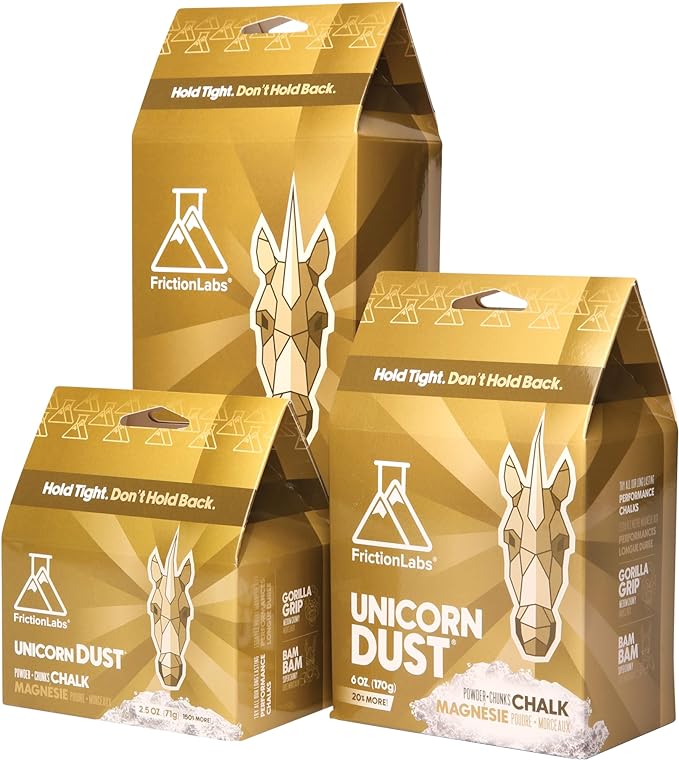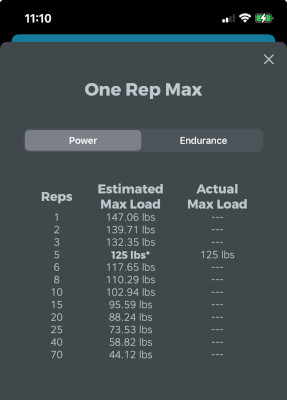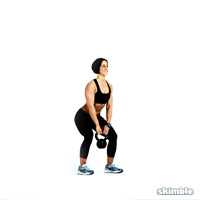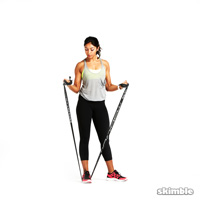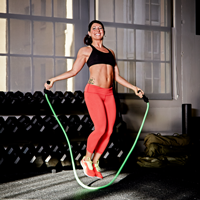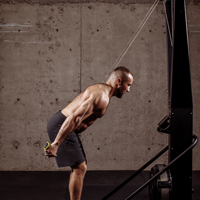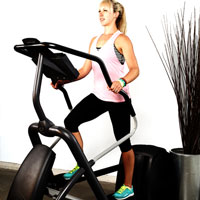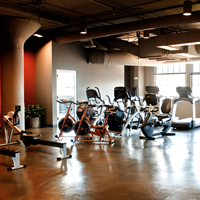Hangboard Workouts
Workout Trainer is full of free workouts that use hangboard and other equipment. PRO+ members also have access to all of our custom training programs created by certified personal trainers. Download the app to learn how to do hangboard exercises and more!
About Hangboards
Using a hangboard, also known as a fingerboard, for rock climbing training offers a wealth of fantastic benefits to climbers at all levels. This specialized piece of equipment serves as a powerful tool to enhance finger strength, grip endurance, and overall upper body power. Regular hangboard workouts not only bolster finger strength but also contribute to injury prevention by fostering improved hand and wrist stability. Furthermore, hangboard training empowers climbers to monitor their progress, set and achieve specific goals, making it an indispensable resource for those aiming to elevate their climbing abilities and conquer more challenging routes with confidence. Workout Trainer has a variety of hangboard workouts to help you get started and you can easily add your own protocols to track your progress.
Our selection of Hangboard Workouts
Workout Trainer has a large selection of free hangboard workouts. Download the app to find the best workouts for you based on your equipment.
![Newbie Hangboard Workout Newbie Hangboard Workout]()
10 minutes, Beginner
![Hooper's Hangboard with Min Edge Hooper's Hangboard with Min Edge]()
22 mins 22 secs, Intense
![2x/day Finger Health Hangboard 2x/day Finger Health Hangboard]()
11 mins 55 secs, Moderate
![Climber Home Workout Climber Home Workout]()
22 mins 48 secs, Moderate
![At-Home Climb Training | Level 2 At-Home Climb Training | Level 2]()
30 mins 59 secs, Moderate
![At-Home Climb Training | Level 3 At-Home Climb Training | Level 3]()
30 mins 53 secs, Intense
![At-Home Climb Training | Level 1 At-Home Climb Training | Level 1]()
28 mins 59 secs, Beginner
![At-Home Climb Training | Level 4 At-Home Climb Training | Level 4]()
26 mins 50 secs, Intense
![Pull-Up Variations for Climbers Pull-Up Variations for Climbers]()
7 mins 23 secs, Intense
![Hangboard Basics for Beginners Hangboard Basics for Beginners]()
4 mins 20 secs, Beginner
![Beginner Hangboard Training Beginner Hangboard Training]()
45 mins 15 secs, Beginner
![Intro to Hangboarding Intro to Hangboarding]()
13 mins 59 secs, Beginner
Beastmaker 2000 Fingerboard
Developed by elite athletes in the UK, the Beastmaker 2000 fingerboard has become part of any serious climber's training kit. It is made of wood, which offers excellent natural grip, porosity and texture. All the Beastmaker holds are also radiused in order to keep the chances of tweaking to a minimum.
Buy Now
Workouts that only use Hangboards
These workouts only use hangboards and no other equipment!
![Newbie Hangboard Workout Newbie Hangboard Workout]()
10 minutes, Beginner
![Hooper's Hangboard with Min Edge Hooper's Hangboard with Min Edge]()
22 mins 22 secs, Intense
![2x/day Finger Health Hangboard 2x/day Finger Health Hangboard]()
11 mins 55 secs, Moderate
![Pull-Up Variations for Climbers Pull-Up Variations for Climbers]()
7 mins 23 secs, Intense
![Hangboard Basics for Beginners Hangboard Basics for Beginners]()
4 mins 20 secs, Beginner
![Beginner Hangboard Training Beginner Hangboard Training]()
45 mins 15 secs, Beginner
![Hooper's Hangboard with Weight Hooper's Hangboard with Weight]()
22 mins 22 secs, Intense
![Hooper's Hangboard Short Version Hooper's Hangboard Short Version]()
2 mins 33 secs, Intense
![2x/day Follow-Along Hangboard 2x/day Follow-Along Hangboard]()
9 mins 40 secs, Moderate
![Hangboard Follow Along Hangboard Follow Along]()
30 mins 18 secs, Moderate
![Hangboard Workout Hangboard Workout]()
9 mins 10 secs, Moderate
![Power Endurance Power Endurance]()
24 mins 30 secs, Intense
TRANGO Rock Prodigy Hangboard
This hangboard has an amazing variety of edges, pockets and pinches to train on. We also like that it comes in two pieces so you can adjust the width to fit your shoulders.
Buy Now
Hangboard Exercises
Workout Trainer has a large selection of hangboard exercises to learn, log and incorporate into your fitness regimen. Learn how to do them properly, find workouts that include them, and create your own workouts using them once you have mastered the technique.
Friction Labs Unicorn Dust Chalk
Non-toxic, silica-free and pigment-free chalk that is safe for all skin types. Friction Labs refines all their chalk, stripping out fillers and artificial drying agents found in other chalks that can dry out and damage your skin. Super fine. Super niiiice! Premium chalk makes a big difference.
Buy Now
Hangboard Protocols for Climbing Training
Hangboard workouts are a crucial component of training for climbing, targeting finger strength and grip endurance which are vital for climbers at all levels. Various protocols cater to different skill levels and training goals. The Repeaters method involves hanging from the board for a set amount of time (generally 5-10 seconds), followed by a short rest (~3-10 seconds), and is repeated multiple times in a single set. Then you take a longer rest (3-5 minutes) before starting another set. Depending on your ability you can aim to complete 3-7 sets of repeaters in a single workout. The Max Hangs protocol focuses on maximizing grip strength by holding onto the board for short periods with maximum effort, followed by longer rest intervals, ideal for advanced climbers looking to push their limits. Generally you will wear your climbing harness and attach weight plates to it to increase the load, or run the weights through a pulley system to reduce the load below body weight for smaller or more difficult holds (e.g. pinches). For max hangs you will generally do a single hang of 5-10 seconds per set, then rest 3 minutes. Aim to complete 3-5 sets at your maximum load. And make sure to do proper warmup sets to get you there. Workout Trainer makes it really easy to find and create your own hangboard protocols to help you progress.
Wooden vs. Plastic Hangboards
Wooden hangboards are favored for their natural feel and lower skin abrasion, making them ideal for climbers engaging in frequent, long-duration training sessions. Wood's gentle touch allows for extended training without the harsh wear on the skin that plastic boards might cause. However, they often come at a higher price and may lack the variety of grip types found on plastic boards. Plastic hangboards, on the other hand, are more affordable and offer a wider range of grip shapes and sizes, catering to a broader spectrum of exercises and skill levels. The downside is that plastic can be tougher on the skin and may lead to quicker fatigue or discomfort, limiting prolonged training sessions.
One Piece vs. Two Piece Hangboards
One piece hangboards offer a fixed layout, ensuring consistent grip placement across training sessions. This uniformity is excellent for structured training where measuring progress and replicating workouts is crucial. However, the fixed nature means less flexibility in adjusting grips to fit different shoulder widths or preferences. Two piece hangboards provide this flexibility, allowing climbers to adjust the spacing between the two sections to better match their body size and reduce the risk of injury. This adaptability makes two piece boards a favorable option for climbers sharing equipment or those concerned about ergonomics. The trade-off is that they may require more time to set up and ensure even alignment for balanced training.
Single Hand with Loading Pin Lifts vs. Both Hands on Hangboard Above the Head
When comparing single hand training with a loading pin to using both hands on a hangboard, each method places different stress on the body, with particular implications for the lower back and shoulders. Training with a single hand using a loading pin, where weights are lifted directly by one hand, primarily targets finger and grip strength in isolation. This method can exert significant strain on the lower back, especially if proper form is not maintained or if the climber progresses to heavier weights without adequate core strength. It's crucial for climbers to engage their core and maintain a neutral spine to mitigate the risk of lower back injuries. Conversely, training with both hands on a hangboard above the head shifts the focus from isolated finger strength to more comprehensive engagement of the upper body, particularly the shoulders. This method can put considerable stress on the shoulder joints, especially in positions involving wide grips or when hanging from smaller holds. Over time, this can lead to overuse injuries or exacerbate existing shoulder issues. Climbers utilizing this method should ensure they incorporate adequate shoulder-strengthening and mobility exercises into their routine to support healthy shoulder function. Both methods, while effective in improving climbing-related strength, require careful attention to technique and gradual progression to prevent injury and ensure balanced muscle development.
Reps & Sets Logging in Workout Trainer
Track your reps & sets for hangboard exercises. See your estimated 1-rep max and then try to beat it! Smartly progress each time you perform an exercise and see your improvement over time.
![Download on the App Store]()
![Download Workout Trainer from Google Play.]()

 Find a Program
Find a Program
 Search
Search
 Workout Trainer
Workout Trainer































